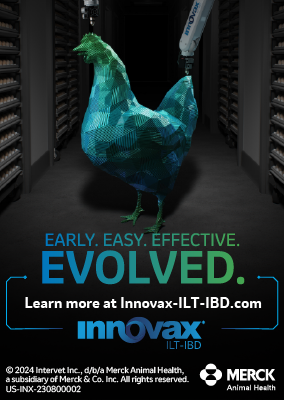Fifth in a series
There is no escaping coccidiosis, but there are options to manage it in a broiler flock, including vaccination.
Careful attention to the coccidiosis vaccination process and follow-up monitoring will go a long way toward ensuring a positive outcome. However, even the best programs will encounter an occasional hiccup.
“Taking a methodical approach to reviewing the vaccination process can identify what went wrong and where adjustments may be needed,” says Charlie Broussard, DVM, Merck Animal Health.
Start with these basics
If the vaccine-monitoring options yield a coccidial lesion profile that falls outside of expected guidelines, or if necrotic enteritis (NE) develops, “then it’s time for a deeper investigation,” he notes.
Broussard offers the following checklist as a troubleshooting guide to ensure birds are appropriately exposed to Eimeria oocysts and develop effective immunity.
✔ Vaccine storage
- Check the refrigerator storing the vaccine for uneven internal temperatures, as this may result in frozen or partially frozen vials. Never use any vaccine suspected to have been frozen. Consider contacting the manufacturer to microscopically evaluate the vaccine for evidence of damage consistent with freezing.
✔ Vaccine administration
- Check the volume of water applied to the chick box; it should be 21 ml.
- Was the correct dye and amount used to monitor vaccine uniformity and encourage preening? Check the vaccine manufacturer’s guidelines.
- Monitor the vaccine spray pattern in the chick box for uniformity.
- Were chicks provided adequate lighting, temperature and time to preen at the hatchery?
✔ Carryover from in-feed anticoccidial programs
- If the previous in-feed anticoccidial program was losing efficacy prior to vaccination, excessive numbers of oocysts can remain in the litter to overexpose the next flock of chicks, Broussard points out. Consider rotating to a different class of anticoccidials to control wild strains in the house before introducing a vaccine to the program.
- When vaccinating, guard against accidental inclusion of anticoccidial medication in the starter feed, which could kill the live oocysts in the vaccine.
✔ House and litter management
- Ensure bird density is not too high nor too low for proper vaccine-oocyst cycling. “Birds need consistent exposure to these infective oocysts to build immunity,” Broussard emphasizes.
- Check minimum ventilation, condensation associated with cold weather, heavy bird concentration and incorrect ration formulation — all of which may cause high litter-moisture content or caking.
- If litter is too wet, it causes excessive oocyst sporulation. Litter that is too dry or dusty will not support adequate sporulation.
- Is litter material absorptive? Also, litter depth should be 4 to 6 inches.
- Was litter cleanout excessive? Or were birds placed on new litter? Both can limit exposure to sporulated oocysts.
✔ Were birds treated with amprolium?
- Treating flocks with the anticoccidial amprolium may slow or even stop birds from developing full vaccine immunity, which may trigger a coccidiosis break later in the grow-out cycle. “Amprolium use should be considered a short-term ‘patch’ until underlying issues can be corrected,” Broussard notes.
- Review house-management practices, including lighting and feeding programs, to ensure that litter-eating is not occurring. Birds that litter-eat may consume excessive oocysts and bacteria.
- Amprolium treatment is discouraged during a coccidiosis vaccination program, except in emergency situations until underlying problems can be corrected, Broussard points out. “If amprolium treatment is necessary, use the lowest dose for only 2 days.”
- Scenarios that require amprolium treatment include:
- High levels of resistant oocysts carried over from failing coccidiosis-control programs.
- An early, extreme coccidial challenge associated with high litter moisture.
Specific steps to address NE breaks
Because NE can be so disruptive to the growing bird’s development and welfare, it’s best to be prepared to stay ahead of that risk.
✔ Check coccidial cycling during the monitoring program
- Scores of +3 or +4 in multiple birds constitute excessive coccidial cycling and corrective action is needed, Broussard notes.
✔ Do starter and grower rations contain an antibiotic with anti-clostridial activity?
- If so, what is the inclusion rate and how long has the antibiotic been used?
- Factors determining onset of NE include:
- Is the in-feed antibiotic in the correct feed?
- Is the in-feed antibiotic at the correct level for Clostridium control?
- Has antibiotic resistance to Clostridium developed?
✔ Was an in-feed anticoccidial included in the starter or grower ration?
- Early inclusion may disrupt coccidial vaccine cycling.
- For hybrid (bioshuttle) programs, ensure that an in-feed anticoccidial is not introduced to birds earlier than 15 days.
✔ Was litter properly prepared between flocks?
- High litter moisture favors Clostridium bacterial growth. Review bird density, litter type and depth, ventilation and ration formulation, Broussard says.
- Litter amendments help reduce ammonia and pH levels, creating a poor environment for clostridial species and reducing stress on the bird.
- Windrowing litter between flocks may break the cycle of NE on farms.
✔ Avoid rations with wheat, bakery meal, distillers’ dried grains with solubles, barley or rye
- These feed ingredients can damage the intestinal mucosa and lead to NE.
✔ Review fat-source quality
- Rancid fats, unstable ethanol corn-oil byproduct and poor-quality acidulated oils can lead to NE.
✔ Are appropriate enzymes included at sufficient levels?
- Use appropriate dietary enzymes to improve ingredient digestibility and minimize NE incidence.
✔ Monitor ration for ingredients containing high Clostridium spore counts
- Clostridium is the pathogen responsible for NE.
✔ Does the region have high soil or water pH levels?
- High pH favors Clostridium bacterial growth, so water treatment may be beneficial.
✔ Did birds get chilled from 10 to 21 days?
- This is especially critical in antibiotic-free and no-antibiotics-ever flocks.
- Cold birds are stressed and are unable to maintain body temperature; in turn the birds overeat. “This sends excess protein in the distal GI tract, which is known to cause clostridial blooms and potentially NE,” Broussard says.
✔ Was feed presentation consistent during the transition from starter to grower?
- Transitioning from crumbles to a pelleted feed may restrict feed consumption if birds do not readily accept the new diet. This also can exacerbate litter eating.
✔ Avoid brooding conditions or issues that can cause feed restrictions
Control other pathogens
While the focus in this series has been on coccidiosis, strategies to minimize exposure to other pathogens, such as viruses, bacteria and protozoa, are beneficial to overall flock health, productivity and well-being.
“That’s why it’s critical to develop and implement a sound biosecurity program that minimizes the introduction of pathogens onto the poultry farm, but also between flock groups,” Broussard says. Here are areas to consider.
- Minimize the bacterial load through water treatments using buffered organic acids such as citric, lactic, propionic, benzoic, tannic and acetic acids, as well as chlorine compounds. “Water-treatment products may be used throughout the grow-out cycle but must be discontinued 24 hours prior to water vaccination,” he notes.
- Maintain healthy immune status of flocks with vaccination programs against immunosuppressive diseases such as Marek’s disease, infectious bursal disease, reovirus and chicken infectious anemia virus.
- Administer vitamin and trace-mineral supplements at recommended levels during the peak vaccinal cycling period.
- Help the bird maintain a healthy and balanced intestinal microflora by administering phytochemicals, probiotics, acids, prebiotics or competitive exclusion (CE) products. “Prebiotics, probiotics and CE products are more effective when introduced to the bird as early as possible before they are delivered to the farm,” Broussard says.
The key to a successful coccidiosis vaccination program is a healthy bird, and that involves management and flock-health strategies that give the animal’s immune system a fighting chance early on.
Other articles in this series:
Don’t overlook the basics when using coccidiosis vaccines
Coccidiosis vaccination: Are you creating an environment for success?
Managing feed, water critical for coccidiosis vaccination success
Veterinarian offers tips for monitoring effectiveness of coccidiosis-vaccination program
Editor’s note: Content on Modern Poultry’s Industry Insights pages is provided and/or commissioned by our sponsors, who assume full responsibility for its accuracy and compliance.








